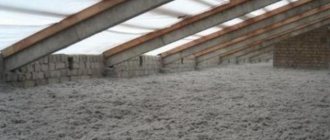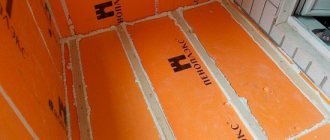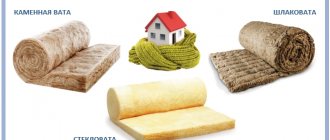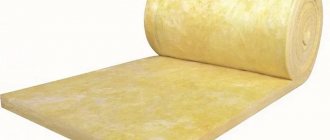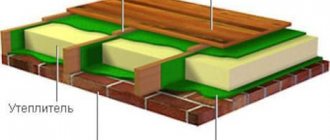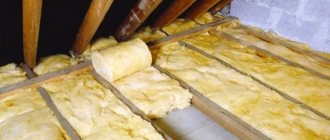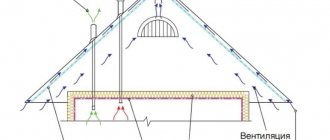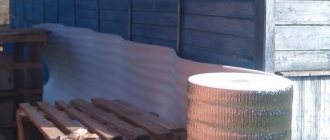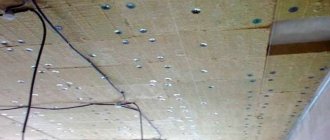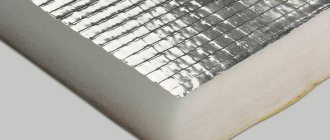How much does 1 cube of expanded clay cost?
Prices for expanded clay
| Fraction | Volume | Price |
| Expanded clay in bulk Fraction 5-10 mm | 1 m³ | 1,700 rub. |
| Expanded clay in bulk Fraction 10-20 mm | 1 m³ | 1,200 rub. |
| Expanded clay in bulk Fraction 10-20 mm | 1 m³ | 1,650 rub. |
| Expanded clay in bulk Fraction 10-20 mm | 1 m³ | 1,900 rub. |
Main types of insulation and their characteristics
The following materials are mainly used to insulate ceilings in a private house:
Today you can buy dozens of types of insulation on the market.
- mineral wool;
- Styrofoam;
- expanded clay;
- sawdust.
Mineral wool
Advantages of mineral wool:
- despite the fact that this material has a cellular structure, various beetles, worms and other insects cannot grow inside it, so mineral wool is an almost ideal material for biological safety; Mineral wool is one of the most popular insulation materials
- has increased fire resistance (during a fire, mineral wool will not catch fire and will not emit harmful chemicals until the room temperature reaches 450C-550C°);
- thanks to good heat transfer and a minimal level of thermal conductivity, the house will be warm in winter and cool in summer;
- environmental cleanliness.
Mineral wool also has its disadvantages:
- porous insulation of any type always allows steam to pass through and, as a result, absorbs moisture (at the same time, the quality of mineral wool as a heat storage device will rapidly approach zero);
- the maximum effective operational life of this insulation is no more than 10 years (a relatively short period);
- high gyroscopicity;
- it may contain binding resins that are not entirely healthy for health, but this mainly concerns its unscrupulous manufacturers (to put it bluntly, we are talking mainly about Chinese manufacturers).
Schematic representation of an insulated ceiling
Styrofoam
The cheapest of all types of ceiling insulation is, of course, the well-known polystyrene foam (and outbuildings are most often insulated with clay). Despite its cheapness and visually apparent fragility, this material is still worth considering as insulation: it has some important positive characteristics.
It is also important to add that expanded polystyrene (this is the official name for foam in the construction industry) is often used in conjunction with other thermal insulation materials (especially when it comes to ceilings - not only in the house, but also in the garage).
Polystyrene foam is one of the cheapest materials
The advantages of polystyrene foam as insulation include the following:
- this material is completely indifferent to moisture and can be used indoors with extremely high humidity levels (up to 99%);
- mold cannot a priori form in it (and on it), since the material is completely resistant to fungi of various origins;
- cheapness (a ton of polystyrene foam does not even cost $100 - this amount is enough for the entire palace of Scheherizade, and not just for an ordinary house, roof, attic or roof);
- lightness (virtually does not bear additional load on the floors and foundation of the building);
- long service life;
- can withstand severe temperature changes (from -65C° to +50C°), which makes it possible to use it both in the Far North and in the southern regions of Russia.
Of course, polystyrene foam also has its disadvantages:
- minimal mechanical strength (the smallest force is enough to pierce the foam or deform it - everyone knows this for sure from infancy);
- expanded polystyrene has an air permeability coefficient of 10% - this is negligible (the material practically does not allow air to pass through - the room will be cool in winter and quite hot in the warm season, and this is not entirely good);
- easily destroyed under the influence of furniture varnish and paints made on the basis of nitroglycerin (modern facade paints contain large quantities of it, with the exception of oil and epoxy paints).
In general, we can conclude that polystyrene foam is an extremely cheap material that is easy to install with your own hands, but it is still not an effective insulation material (especially for houses made of foam blocks).
It is suitable for a temporary home (dacha, for example), but for a permanent home it is better not to use it (technology often simply does not allow it).
Table with characteristics of some types of insulation
Expanded clay
Among the advantages of this material are an extremely low thermal conductivity coefficient, ease of installation, high sound insulation and noise-absorbing properties. By the way, noise and sound are completely different things, although many do not understand this (and yet manufacturers of building materials classify them differently).
Expanded clay is divided into several types, depending on the size of the fractions
Expanded clay also has disadvantages: a porous structure and extreme fragility (a particle of expanded clay can be crushed into powder by literally pressing the little fingers of both hands).
The process of insulating the ceiling with expanded clay
- The ceiling is completely cleaned, dust, dirt, old coating and insulation, if any, are removed from it (reviews in this regard are positive);
- Waterproofing is being installed. Thermal insulation film is always and under any circumstances installed exclusively with an overlap; the joints are connected not with glue, as when laying any other types of insulation, but with special tape (expanded clay is very afraid of any moisture - the use of liquid must be kept to a minimum). The waterproofing film itself must extend onto the wall within 8-10 centimeters.
- Expanded clay is poured in (here it is necessary to take into account the shrinkage of the ceiling surface, especially in a wooden house). By the way, the expanded clay layer should be at least 15 centimeters deep; in this case, the larger it is, the better the physical properties of the thermal insulation will be;
- Leveling plaster is applied (but if you insulate the floor, you will need to make a screed - this is a note to the builder).
Scheme of laying expanded clay under the screed
Sawdust
Sawdust has been used as insulation for a very long time. Strictly speaking, they have only 2 main advantages: low cost and good thermal insulation properties. In simple terms, we can say the following: insulating the ceiling with sawdust is a more correct solution when compared with expanded clay, but in terms of its technical qualities it is noticeably inferior to polystyrene foam and mineral wool. Sawdust cannot be used just like that, out of the blue, under no circumstances.
They must meet the following criteria:
- be aged for one year (the content of wood resins and gluten should be no more than 10%-12%, which is impossible in fresh material); The smaller the fraction of sawdust, the more saturated in color they are
- It is not allowed to use sawdust even with a minimum moisture content (they will simply crumple up, and various insects and other “living creatures” will subsequently appear on the ceiling);
- they should not contain mold and fungi (for example, they can appear if the sawdust was first wet and then dried for a long time - this is what unscrupulous manufacturers sometimes do);
- The sawdust size should be medium - sawdust that is too small requires a larger amount of insulating layer, that is, putty or cement screed.
Styrofoam
Very often polystyrene foam is used for insulation. Its main advantages are:
Among the disadvantages of foam plastic under floor screed is its toxicity. However, it all depends on the type of foam. Suitable for residential premises:
In order for a floor screed with foam to have all the necessary parameters, it is necessary to select a material of a certain density. Therefore, when buying polystyrene foam, look at its markings - after the letters PPT there should be a number no lower than 25; such sheets are best suited for the heat-insulating layer of the screed. It is also worth paying attention to the PSB marking.
Another disadvantage that this material has is the complexity of its installation. In order for the foam floor screed to be durable, it is necessary to create the most even surface possible. To do this, quartz sand is first poured onto the rough screed, and only after that the insulation sheets are laid.
Healthy! For even cutting of insulation sheets, it is best to use a special construction cutter with a hot wire.
Foam sheets must be laid very carefully. If cracks or gaps have formed between the plates, they must be eliminated using polyurethane foam. Otherwise, the thermal insulation properties of the material will noticeably decrease.
If the foam screed will be located close to the foundation (first floor), then you should choose a material with a thickness of at least 10 cm, and for the upper floors slabs 5 cm thick will be sufficient.
Table of thermal conductivity of thermal insulation materials
To make it easier to keep your house warm in winter and cool in summer, the thermal conductivity of walls, floors and roofs must be at least a certain figure, which is calculated for each region.
The composition of the “pie” of walls, floor and ceiling, the thickness of the materials are taken into account so that the total figure is no less (or better yet, at least a little more) recommended for your region. Heat transfer coefficient of modern building materials for enclosing structures
When choosing materials, it is necessary to take into account that some of them (not all) conduct heat much better in conditions of high humidity. If such a situation may occur for a long period of time during operation, the thermal conductivity for this condition is used in the calculations. The thermal conductivity coefficients of the main materials used for insulation are given in the table.
| Name of material | Thermal conductivity coefficient W/(m °C) | ||
| Dry | At normal humidity | At high humidity | |
| Woolen felt | 0,036-0,041 | 0,038-0,044 | 0,044-0,050 |
| Stone mineral wool 25-50 kg/m3 | 0,036 | 0,042 | 0,,045 |
| Stone mineral wool 40-60 kg/m3 | 0,035 | 0,041 | 0,044 |
| Stone mineral wool 80-125 kg/m3 | 0,036 | 0,042 | 0,045 |
| Stone mineral wool 140-175 kg/m3 | 0,037 | 0,043 | 0,0456 |
| Stone mineral wool 180 kg/m3 | 0,038 | 0,045 | 0,048 |
| Glass wool 15 kg/m3 | 0,046 | 0,049 | 0,055 |
| Glass wool 17 kg/m3 | 0,044 | 0,047 | 0,053 |
| Glass wool 20 kg/m3 | 0,04 | 0,043 | 0,048 |
| Glass wool 30 kg/m3 | 0,04 | 0,042 | 0,046 |
| Glass wool 35 kg/m3 | 0,039 | 0,041 | 0,046 |
| Glass wool 45 kg/m3 | 0,039 | 0,041 | 0,045 |
| Glass wool 60 kg/m3 | 0,038 | 0,040 | 0,045 |
| Glass wool 75 kg/m3 | 0,04 | 0,042 | 0,047 |
| Glass wool 85 kg/m3 | 0,044 | 0,046 | 0,050 |
| Expanded polystyrene (foam plastic, EPS) | 0,036-0,041 | 0,038-0,044 | 0,044-0,050 |
| Extruded polystyrene foam (EPS, XPS) | 0,029 | 0,030 | 0,031 |
| Foam concrete, aerated concrete with cement mortar, 600 kg/m3 | 0,14 | 0,22 | 0,26 |
| Foam concrete, aerated concrete with cement mortar, 400 kg/m3 | 0,11 | 0,14 | 0,15 |
| Foam concrete, aerated concrete with lime mortar, 600 kg/m3 | 0,15 | 0,28 | 0,34 |
| Foam concrete, aerated concrete with lime mortar, 400 kg/m3 | 0,13 | 0,22 | 0,28 |
| Foam glass, crumbs, 100 - 150 kg/m3 | 0,043-0,06 | ||
| Foam glass, crumbs, 151 - 200 kg/m3 | 0,06-0,063 | ||
| Foam glass, crumbs, 201 - 250 kg/m3 | 0,066-0,073 | ||
| Foam glass, crumbs, 251 - 400 kg/m3 | 0,085-0,1 | ||
| Foam block 100 - 120 kg/m3 | 0,043-0,045 | ||
| Foam block 121-170 kg/m3 | 0,05-0,062 | ||
| Foam block 171 - 220 kg/m3 | 0,057-0,063 | ||
| Foam block 221 - 270 kg/m3 | 0,073 | ||
| Ecowool | 0,037-0,042 | ||
| Polyurethane foam (PPU) 40 kg/m3 | 0,029 | 0,031 | 0,05 |
| Polyurethane foam (PPU) 60 kg/m3 | 0,035 | 0,036 | 0,041 |
| Polyurethane foam (PPU) 80 kg/m3 | 0,041 | 0,042 | 0,04 |
| Cross-linked polyethylene foam | 0,031-0,038 | ||
| Vacuum | |||
| Air +27°C. 1 atm | 0,026 | ||
| Xenon | 0,0057 | ||
| Argon | 0,0177 | ||
| Airgel (Aspen aerogels) | 0,014-0,021 | ||
| Slag | 0,05 | ||
| Vermiculite | 0,064-0,074 | ||
| Foam rubber | 0,033 | ||
| Cork sheets 220 kg/m3 | 0,035 | ||
| Cork sheets 260 kg/m3 | 0,05 | ||
| Basalt mats, canvases | 0,03-0,04 | ||
| Tow | 0,05 | ||
| Perlite, 200 kg/m3 | 0,05 | ||
| Expanded perlite, 100 kg/m3 | 0,06 | ||
| Linen insulating boards, 250 kg/m3 | 0,054 | ||
| Polystyrene concrete, 150-500 kg/m3 | 0,052-0,145 | ||
| Granulated cork, 45 kg/m3 | 0,038 | ||
| Mineral cork on a bitumen basis, 270-350 kg/m3 | 0,076-0,096 | ||
| Cork flooring, 540 kg/m3 | 0,078 | ||
| Technical cork, 50 kg/m3 | 0,037 |
Some of the information is taken from standards that prescribe the characteristics of certain materials (SNiP 23-02-2003, SP 50.13330.2012, SNiP II-3-79* (Appendix 2)). Those materials that are not specified in the standards are found on the manufacturers’ websites
Since there are no standards, they can differ significantly from different manufacturers, so when purchasing, pay attention to the characteristics of each material purchased
Usage
It is very popular today, and this is due to the fact that it has a long service life, is easy to install and has high soundproofing characteristics. It is these positive qualities that allowed expanded clay to become one of the most popular. Expanded clay is an inexpensive and easy-to-use building material.
In the photo - expanded clay for construction
It has a fairly wide scope of application, among which are:
- thermal insulation of floors, which is achieved due to low thermal conductivity;
- thermal insulation of the walls of loggias, attics and basements, since heat loss can be reduced by 70%;
- construction of residential buildings, industrial facilities, cottages and baths;
- design measures on a personal plot: the use of tiles, embankments;
- actively used in agriculture when applied to the soil, it is possible to increase plant growth rates;
- in the manufacture of filters in wastewater treatment plants;
- in the production of lightweight concrete, when expanded clay granules act as a filler.
When choosing high-quality bulk material, it is important to know the difference between crushed stone and gravel.
Insulation with spray insulation
By the way, quite recently an innovative sprayed heat insulator based on polyurethane foam (PPU) appeared on sale. While it has not yet become popular among domestic homeowners, this material has good positive characteristics:
- minimal thermal conductivity; This type of thermal insulation has not yet become popular in Russia
- high installation speed (5-7 times faster than laying conventional insulation);
- convenience.
True, the spraying device itself must have a power of at least 380 W, and the compressor capacity must be at least 700 liters per hour. It is usually customary to rent such equipment rather than buy it for one-time use. However, sprayed thermal insulation also has its significant disadvantages, according to the statements of many builders.
Among them are the following: quite high cost, polyurethane foam has a low fire resistance class (in the event of a serious fire, the house will blaze like a match - this is the most significant drawback).
After drying, the sprayed heat insulator acquires a fibrous structure
You can add a special impregnation to the heat insulator to reduce flammability, but the foam of the polyurethane foam will not be as strong. In general, you need to decide all this yourself; here the pros and cons are approximately equal.
How to make an insulated dry screed
The advantage of dry screed is that it is easier and faster to make than cement-sand screed. Insulation of floors under dry screed has some peculiarities. Materials for dry screed, as a rule, deteriorate from high humidity.
For example, gypsum fiber sheet, a very common material, does not tolerate moisture, as it increases in size and loses its properties. Therefore, the presence of a dew point on the surface or inside the dry screed is not allowed.
Of course, the screed acts as a layer of interior finishing, and the dew point can only be found on it with very unsatisfactory insulation and cold floors. Let's take a closer look at how to insulate floors under dry screed so that they last a long time and the house is comfortable.
Design of floor insulation under dry screed
The base of the subfloor can be anything. Common: reinforced concrete floors over the basement, over the underground, floors on the ground, or wooden floors over the ventilated underground.
Table of thermal conductivity of materials on Cl...
| Material | Density, kg/m3 | Thermal conductivity, W/(m deg) | Heat capacity, J/(kg deg) |
| Rubble masonry made of medium-density stones | 2000 | 1.35 | 880 |
| Gas silicate masonry | 630…820 | 0.26…0.34 | 880 |
| Masonry made of gas silicate thermal insulation boards | 540 | 0.24 | 880 |
| Masonry of ordinary clay bricks on cement-perlite mortar | 1600 | 0.47 | 880 |
| Masonry of ordinary clay bricks (GOST 530-80) on cement-sand mortar | 1800 | 0.56 | 880 |
| Masonry of ordinary clay bricks on cement-slag mortar | 1700 | 0.52 | 880 |
| Masonry of ceramic hollow bricks with cement-sand mortar | 1000…1400 | 0.35…0.47 | 880 |
| Small brick masonry | 1730 | 0.8 | 880 |
| Masonry made of hollow wall blocks | 1220…1460 | 0.5…0.65 | 880 |
| Masonry made of 11-hollow silicate bricks with cement-sand mortar | 1500 | 0.64 | 880 |
| Masonry made of 14-hollow silicate bricks with cement-sand mortar | 1400 | 0.52 | 880 |
| Sand-lime brick masonry (GOST 379-79) with cement-sand mortar | 1800 | 0.7 | 880 |
| Triple brick masonry (GOST 648-73) with cement-sand mortar | 1000…1200 | 0.29…0.35 | 880 |
| Cellular brick masonry | 1300 | 0.5 | 880 |
| Slag brick masonry with cement-sand mortar | 1500 | 0.52 | 880 |
| Masonry "Poroton" | 800 | 0.31 | 900 |
| Maple | 620…750 | 0.19 | — |
| Leather | 800…1000 | 0.14…0.16 | — |
| Technical composites | — | 0.3…2 | — |
| Oil paint (enamel) | 1030…2045 | 0.18…0.4 | 650…2000 |
| Silicon | 2000…2330 | 148 | 714 |
| Organosilicon polymer KM-9 | 1160 | 0.2 | 1150 |
What affects the ability of polystyrene foam to conduct heat?
To clearly understand what thermal conductivity is, let’s take a piece of material one meter thick and an area of one square meter. Moreover, we heat one side of it and leave the other cold. The difference between these temperatures should be tenfold. By measuring the amount of heat that transfers to the cold side in one second, we obtain the thermal conductivity coefficient.
Why is polystyrene foam capable of retaining both heat and cold well? It turns out that it's all about its structure. Structurally, this material consists of many sealed polyhedral cells ranging in size from 2 to 8 millimeters. They have air inside – it makes up 98 percent and serves as an excellent heat insulator. Polystyrene accounts for 2% of the volume. And by weight, polystyrene is 100%, because air, relatively speaking, has no mass.
It should be noted that the thermal conductivity of extruded polystyrene foam remains unchanged over time. This distinguishes this material from other foam plastics, the cells of which are filled not with air, but with another gas. After all, this gas has the ability to gradually evaporate, and the air remains inside the sealed polystyrene foam cells.
When buying polystyrene foam, we usually ask the seller what the density of this material is. After all, we are accustomed to the fact that density and the ability to conduct heat are inextricably linked with each other. There are even tables of this dependence, with which you can choose the appropriate brand of insulation.
| Density of polystyrene foam kg/m3 | Thermal conductivity W/mkv |
| 10 | 0,044 |
| 15 | 0,038 |
| 20 | 0,035 |
| 25 | 0,034 |
| 30 | 0,033 |
| 35 | 0,032 |
However, nowadays they have come up with an improved insulation, which contains graphite additives. Thanks to them, the thermal conductivity of polystyrene foam of various densities remains unchanged. Its value is from 0.03 to 0.033 watts per meter per Kelvin. So now, when purchasing modern, improved XPS, there is no need to check its density.
Marking of polystyrene foam whose thermal conductivity does not depend on density:
| Brand of expanded polystyrene | Thermal conductivity W/mkv |
| EPS 50 | 0.031 — 0.032 |
| EPS 70 | 0.033 — 0.032 |
| EPS 80 | 0.031 |
| EPS 100 | 0.030 — 0.033 |
| EPS 120 | 0.031 |
| EPS 150 | 0.030 — 0.031 |
| EPS 200 | 0.031 |
Organization of floor heating by installing a “warm floor” system
When installing a heated floor system, it is necessary to install a waterproofing layer, then lay insulation (penoplex, polyurethane foam, polystyrene foam, mineral wool mats), cover the structure with aluminum foil, which will act as a heat shield that reflects thermal energy, install the “warm floor” system (lay pipes or electric mats), complete the finishing fill and lay the selected floor covering.
We recommend that you first watch the video below to clearly understand how this happens:
Methods for installing insulation
Insulation from above (from the attic)
External insulation of the ceiling (in the absence of a concrete balcony) is a more preferable option, since it is simply easier to install from the attic area. Some people prefer to insulate the ceiling both from the attic and from the inside, believing that it will be better this way.
In fact, it is enough to carry out insulation only from above, everything else is unnecessary. And from a technical point of view, an additional layer of internal thermal insulation will not give anything: the level of thermal conductivity will be approximately the same. However, everything here is decided by the owner of the house. The work is carried out in several stages:
- The attic is completely cleared of all debris; its surface must be perfectly clean. It is better to use a vacuum cleaner for these purposes (not necessarily a construction one - the most ordinary one will do);
- The space is measured and insulation is purchased. For the attic, polystyrene foam is the best option. The foam sheets should not be very thin, the minimum thickness is 40 millimeters. It is also acceptable to use polystyrene, but its cost will be noticeably higher with relatively identical performance characteristics;
- The entire surface is laid with foam plastic slabs, the remaining “holes” are filled with construction foam - a fairly simple scheme;
- A screed is made on top of the foam, the maximum thickness of which is no more than 50 millimeters.
Schematic representation of an insulated ceiling
If you use mineral wool as insulation, you must build a metal frame under the screed - so it’s better to get by with just foam plastic (in extreme cases, penoplex or expanded polystyrene).
Insulation from outside
Internal ceiling insulation is a somewhat more complex task. You will have to do the following sequentially:
- make steam and hydrological insulation;
- sheathing under which thermal insulation material will need to be installed; Mineral wool is an indispensable building material
- install the insulation itself;
- re-vapor barrier;
- cover the ceiling with any covering material.
As an example, we can consider insulating the ceiling in a house with a wooden beam roof (such houses are most widespread in Russia). By default: climate – moderate, insulation – mineral wool.
Mineral wool for a wooden house is the best option for the simple reason that it does not interact chemically with wood. And even despite the fact that its structure itself is cellular and porous, insects certainly cannot get into it, which is very, very important for a house made of wood.
Scheme of ceiling insulation in frame private houses
You need to do the following to insulate:
- Using a stapler, you need to attach a plastic film to the beams to completely block the access of moisture. The overlap of the canvases is mandatory: it must be at least 10 centimeters.
- The sheathing is made (for sheathing with PVC panels). For such panels, small wooden slats (beams measuring 50*50 millimeters) are sufficient. They must be nailed in increments of 60 centimeters. A cut board may also work.
- The timber gap is filled with mineral wool (you can also use ecowool).
- A second layer of plastic film is laid (again, using a stapler).
- PVC panels are hemmed underneath.
Features of ceiling insulation in a wooden house
Wooden houses are always insulated using the same technology.
Actually, there are not so many features themselves:
- mandatory use of polyethylene film as additional moisture protection (although civil engineering does not require its use);
- It is best to sheathe the ceiling with polyvinyl chloride panels;
- It is better to carry out insulation from the attic.
Approximate diagram of basement and attic ceiling insulation in a wooden house
Table of thermal conductivity of materials on Pa-Pen
| Material | Density, kg/m3 | Thermal conductivity, W/(m deg) | Heat capacity, J/(kg deg) |
| Tow | 150 | 0.05 | 2300 |
| Gypsum wall panels DIN 1863 | 600…900 | 0.29…0.41 | — |
| Paraffin | 870…920 | 0.27 | — |
| Oak parquet | 1800 | 0.42 | 1100 |
| Piece parquet | 1150 | 0.23 | 880 |
| Panel parquet | 700 | 0.17 | 880 |
| Pumice | 400…700 | 0.11…0.16 | — |
| Pumice concrete | 800…1600 | 0.19…0.52 | 840 |
| Foam concrete | 300…1250 | 0.12…0.35 | 840 |
| Foam gypsum | 300…600 | 0.1…0.15 | — |
| Foam ash concrete | 800…1200 | 0.17…0.29 | — |
| Polystyrene foam PS-1 | 100 | 0.037 | — |
| Polyfoam PS-4 | 70 | 0.04 | — |
| Foam plastic PVC-1 (TU 6-05-1179-75) and PV-1 (TU 6-05-1158-78) | 65…125 | 0.031…0.052 | 1260 |
| Foam resopen FRP-1 | 65…110 | 0.041…0.043 | — |
| Expanded polystyrene (GOST 15588-70) | 40 | 0.038 | 1340 |
| Expanded polystyrene (TU 6-05-11-78-78) | 100…150 | 0.041…0.05 | 1340 |
| Expanded polystyrene "Penoplex" | 35…43 | 0.028…0.03 | 1600 |
| Polyurethane foam (TU V-56-70, TU 67-98-75, TU 67-87-75) | 40…80 | 0.029…0.041 | 1470 |
| Polyurethane foam sheets | 150 | 0.035…0.04 | — |
| Polyethylene foam | — | 0.035…0.05 | — |
| Polyurethane foam panels | — | 0.025 | — |
| Penosilalcite | 400…1200 | 0.122…0.32 | — |
| Lightweight foam glass | 100..200 | 0.045…0.07 | — |
| Foam glass or gas glass (TU 21-BSSR-86-73) | 200…400 | 0.07…0.11 | 840 |
| Penofol | 44…74 | 0.037…0.039 | — |
Table of thermal conductivity of materials on M-O
| Magnesia in the form of segments for pipe insulation | 220…300 | 0.073…0.084 | — |
| Asphalt mastic | 2000 | 0.7 | — |
| Basalt mats, canvases | 25…80 | 0.03…0.04 | — |
| Stitched glass fiber mats and strips (TU 21-23-72-75) | 150 | 0.061 | 840 |
| Mineral wool mats stitched (GOST 21880-76) and with a synthetic binder (GOST 9573-82) | 50…125 | 0.048…0.056 | 840 |
| MBOR-5, MBOR-5F, MBOR-S-5, MBOR-S2-5, MBOR-B-5 (TU 5769-003-48588528-00) | 100…150 | 0.038 | — |
| Chalk | 1800…2800 | 0.8…2.2 | 800…880 |
| Copper (GOST 859-78) | 8500 | 407 | 420 |
| Mikanite | 2000…2200 | 0.21…0.41 | 250 |
| Mipora | 16…20 | 0.041 | 1420 |
| Morozin | 100…400 | 0.048…0.084 | — |
| Marble (cladding) | 2800 | 2.9 | 880 |
| Boiler scale (rich in lime, at 100°C) | 1000…2500 | 0.15…2.3 | — |
| Boiler scale (rich in silicate, at 100°C) | 300…1200 | 0.08…0.23 | — |
| Deck flooring | 630 | 0.21 | 1100 |
| Nylon | — | 0.53 | — |
| Nylon | 1300 | 0.17…0.24 | 1600 |
| Neoprene | — | 0.21 | 1700 |
| Wood sawdust | 200…400 | 0.07…0.093 | — |
Date: September 25, 2022
